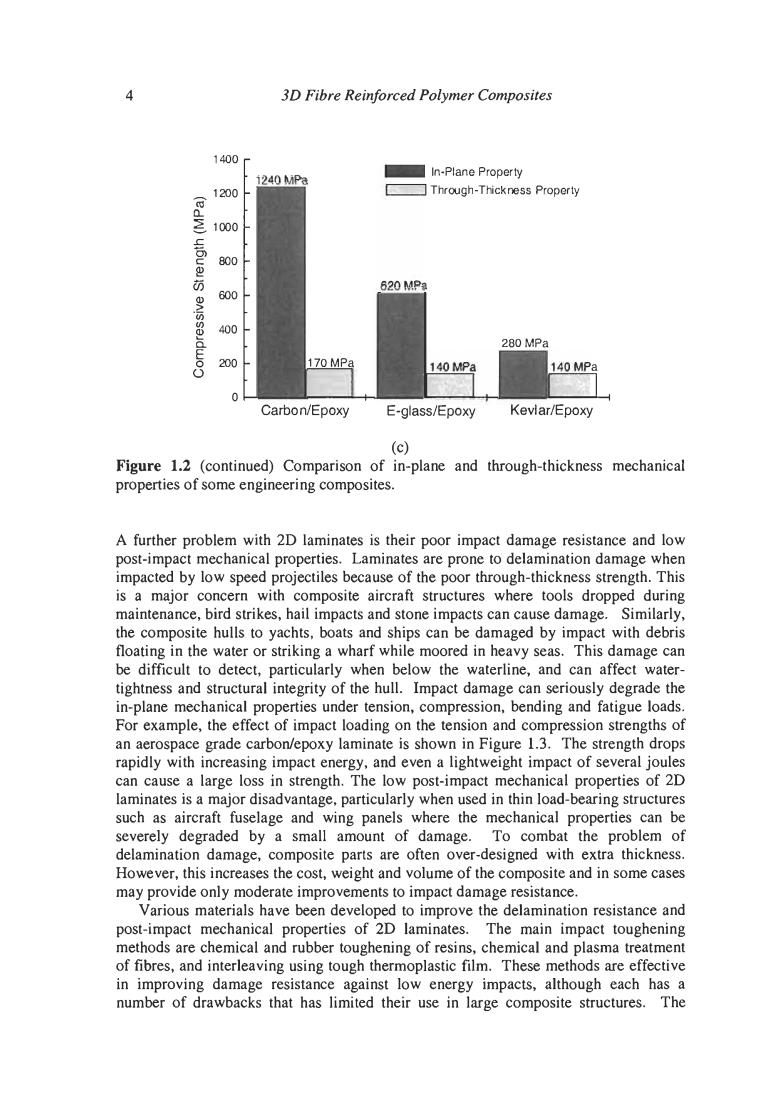正在加载图片...

4 3D Fibre Reinforced Polymer Composites 1400 In-Plane Property 1240Pa 1200 Through-Thickness Property 1000 800 620 MPa 600 400 280 MPa 200 170 MPa 140 MPa 140 MPa 0 Carbon/Epoxy E-glass/Epoxy Kevlar/Epoxy (c) Figure 1.2 (continued)Comparison of in-plane and through-thickness mechanical properties of some engineering composites. A further problem with 2D laminates is their poor impact damage resistance and low post-impact mechanical properties.Laminates are prone to delamination damage when impacted by low speed projectiles because of the poor through-thickness strength.This is a major concern with composite aircraft structures where tools dropped during maintenance,bird strikes,hail impacts and stone impacts can cause damage.Similarly, the composite hulls to yachts,boats and ships can be damaged by impact with debris floating in the water or striking a wharf while moored in heavy seas.This damage can be difficult to detect,particularly when below the waterline,and can affect water- tightness and structural integrity of the hull.Impact damage can seriously degrade the in-plane mechanical properties under tension,compression,bending and fatigue loads. For example,the effect of impact loading on the tension and compression strengths of an aerospace grade carbon/epoxy laminate is shown in Figure 1.3.The strength drops rapidly with increasing impact energy,and even a lightweight impact of several joules can cause a large loss in strength.The low post-impact mechanical properties of 2D laminates is a major disadvantage,particularly when used in thin load-bearing structures such as aircraft fuselage and wing panels where the mechanical properties can be severely degraded by a small amount of damage.To combat the problem of delamination damage,composite parts are often over-designed with extra thickness. However,this increases the cost,weight and volume of the composite and in some cases may provide only moderate improvements to impact damage resistance. Various materials have been developed to improve the delamination resistance and post-impact mechanical properties of 2D laminates.The main impact toughening methods are chemical and rubber toughening of resins,chemical and plasma treatment of fibres,and interleaving using tough thermoplastic film.These methods are effective in improving damage resistance against low energy impacts,although each has a number of drawbacks that has limited their use in large composite structures.The4 30 Fibre Reinforced Polymer Composites 1400 r 1200 m a z 1000 - In-Plane Property L---l Through-Thickness Property 620 MPa + Carbo n/Epoxy E-glass/Epoxy Kevlar/Epoxy (c> Figure 1.2 (continued) Comparison of in-plane and through-thickness mechanical properties of some engineering composites. A further problem with 2D laminates is their poor impact damage resistance and low post-impact mechanical properties. Laminates are prone to delamination damage when impacted by low speed projectiles because of the poor through-thickness strength. This is a major concern with composite aircraft structures where tools dropped during maintenance, bird strikes, hail impacts and stone impacts can cause damage. Similarly, the composite hulls to yachts, boats and ships can be damaged by impact with debris floating in the water or striking a wharf while moored in heavy seas. This damage can be difficult to detect, particularly when below the waterline, and can affect watertightness and structural integrity of the hull. Impact damage can seriously degrade the in-plane mechanical properties under tension, compression, bending and fatigue loads. For example, the effect of impact loading on the tension and compression strengths of an aerospace grade carbodepoxy laminate is shown in Figure 1.3. The strength drops rapidly with increasing impact energy, and even a lightweight impact of several joules can cause a large loss in strength. The low post-impact mechanical properties of 2D laminates is a major disadvantage, particularly when used in thin load-bearing structures such as aircraft fuselage and wing panels where the mechanical properties can be severely degraded by a small amount of damage. To combat the problem of delamination damage, composite parts are often over-designed with extra thickness. However, this increases the cost, weight and volume of the composite and in some cases may provide only moderate improvements to impact damage resistance. Various materials have been developed to improve the delamination resistance and post-impact mechanical properties of 2D laminates. The main impact toughening methods are chemical and rubber toughening of resins, chemical and plasma treatment of fibres, and interleaving using tough thermoplastic film. These methods are effective in improving damage resistance against low energy impacts, although each has a number of drawbacks that has limited their use in large composite structures. The